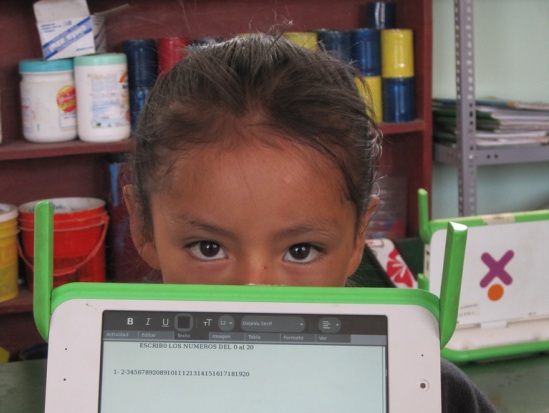
In my point of view the IDB study on OLPC Peru should have evaluated or valued the process of innovation going on. The "Error Message" article by The Economist magazine is a consequence of a study that is not pointing out the main good thing going on in Peru, which I assume is the learning process to innovate education.
What economists and most people do not realize is that the world needs to innovate basic education, but to explain what change is that, is not easy because there are changes advocated by different theories and motivations.
I think that a study that intends to evaluate a 1-to-1 deployment at this moment should first focus on the context and theories that explain how development is connected to digital technology access and use in education. Among many the IADB itself has published papers that explain this (Disrupting Innovation, 2010). Kozma, Infodev, Warschauer, and many others have good publications with contributions for this theme. A treatment/control group study ignores the value of innovation itself and value of the new outputs.
We are living a context where most countries, states or cities don't really know what they want from the 1-to-1 deployments. Of course we all want a better education, but what exactly is that?
The definition of a better education frequently includes things like collaboration, authoring, creativity, leadership, and problem solving. So, if we have such a concept of good education, a study should look for the evidences of this "good education" shouldn't it?
But in the end those types of evidence are not as recognized as grades in math and language tests. Or any other internationally recognized (one size fits all) test. If you give people data with tests results, that's naturally what they are going to look at. This is the way most adults have been educated, this (tests scores) is what they, especially economists and policy makers, trust. But those who are no not studying or somehow immersed on 1-to-1 computing possibilities, don't know that the point here is to build innovation, a process that will take some years, but is so clearly needed.
So what are we really looking for? Are we looking for better grades on standardized tests, one or two years after the kids receive laptops?
Or are we looking for a change in the basic education system, a change for student centered education with active methods, authoring, simulation, and collaboration?
If the latter is the main goal, we must realize it is a long process. We must plan programs as a 10 years process with many changes inside it, develop systems for its evaluation, and validate as well as communicate new evidence of success.
Marta Voelcker is a researcher at Fundación Pensamiento Digital in Brazil.


Great points here Martin - you are very right that education needs to decide what it's for - the factory- employment era proof of mastery of basic skills thats measured by ticking boxes test wise (ie providing the data that any central office requires to run a system) or teaching the problem solving/ social media/ digital publishing/life-long learning skills today's students future jobs will require. Any 1-1 solution that doesn't answer this first (or figure out how to have everyone happy with doing both) will struggle to be interpreted later. Thanks for your post
Thoughtful post, Marta. I fully agree that we need to think about one-to-one deployments in terms of broader educational reform goals and not only in terms of test scores.
My own feeling, though, is that it doesn't have to be an either/or. Standardized tests are flawed measures of what can be accomplished with laptops in schools, but they are not worthless. So in the best one-to-one programs, we would hope that they are both raising children's test scores and accomplishing a lot more.
You are also right, of course, that all of this takes a long time to take place.
I don't think, though, that educational reform will occur merely through, or even principally through, putting technology in the classroom. It takes much broader social and technical infrastructural change. I think it's key to think about and work toward that broader change, rather than focusing narrowly and getting computers into the hands of kids, especially in impoverished countries that can ill-afford individual computers.
Hi, somehow I only saw this comments today. Thank you, I agree, we cannot avoid tests at this moment because other kinds of evaluation are still immature. I also agree that digital technology will not reform the education alone, but I do think that digital technology is a huge, wonderful opportunity to make the reform happen. In this context, what really concerns me, are the cases where policy makers and specialists involved with one to one computing simply ignore the education reform opportunity...